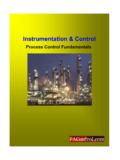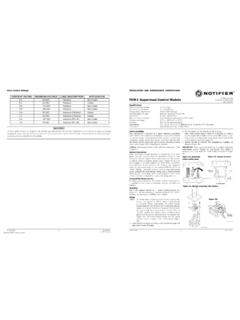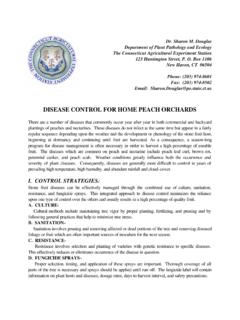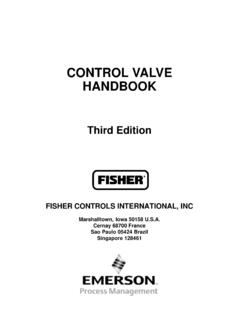Transcription of WELL CONTROL PRINCIPLES AND PROCEDURES …
1 well CONTROL PRINCIPLES AND PROCEDURES FOR COMPLETION, RECOMPLETION, AND WORKOVER (C,R,&W) A. INTRODUCTION Oil and gas well CONTROL PROCEDURES for C, R,& W operations are significantly different than those used when drilling. Though basic pressure considerations are the same, implementation methods vary greatly due to well conditions, which are often unique to individual wells. These conditions include the type of completion, formation pressures exposed to the wellbore, and the reasons for performing the workover. Routine C,R,& W operations often require the implementation of various well CONTROL PROCEDURES . The most common are 1) killing a producing well and 2) controlling kicks, which occur during a workover.
2 An understanding of the differences between these two operations and the effect of routine operations on well CONTROL is essential for the workover supervisor. In this section, specific attention will be paid to pressure and its effect on well CONTROL , causes of kicks and considerations, which affect selection of proper kill PROCEDURES . B. FUNDAMENTALS OF PRESSURE An understanding of basic pressure PRINCIPLES is essential to understanding well CONTROL . Pressure (P) is defined as Force (F) per unit area (A). This concept is illustrated in Figure 1 which shows a brick lying on a table. PRESSURE/FORCE/AREA RELATIONSHIP Sub-figure (a) shows arrows labeled WB and FT which represent the forces exerted by the brick and table respectively.
3 These forces, though shown as applied at a single point (arrows tip to tip), are actually distributed over the area of contact between the brick and table. Sub-figure (b) shows the brick lying on its large side (4 inches wide x 8 inches long), thus the total force is evenly distributed over that area. Knowing the weight of the brick, say 5 pounds, we can calculate the forces acting on any given part of the brick or table. W B 2 = 0,05 m 4 = = 0,1 m 8 = 0,2 m FT 4 = 0,1 m (a) (b) 2 = 0,05 m (c) (d) 8 = 0,2 m Figure 1.
4 Example 1 Imperial (API) F = Weight of brick = 5 pounds A = Area of contact = 8"x 4" = 32 square inches P = Pressure = Force per area = F/A = pounds per square inch (psi). P = 5 / 32 = .156 lbs/sq. in. or .156 psi If a second brick is stacked on top of the first as in Sub-figure (c), the weight (Force) of the bricks double but the area of contact remains the same, thus the pressure doubles. Again looking at the equations for pressure: P = F / A = 2WB / A = (2 x 5) / 32 = 10 / 32 P = .312 psi If the original brick were to be set on end as shown in Sub-figure (d), the force (WB) remains the same (5 lbs) but now the area of contact is smaller (2"x 4").
5 Thus the pressure is: P = F / A = WB / A = 5 / (2 x 4) = 5 / 8 P = .625 psi Metric (SI) Note: on practice Kilogram , which is value of mass, is used as value of weight. Actual value of weight is Newton : 1 N = 1 kg x 0,981 = 0,981 kg Metric oilfield calculations use Kilopascal (kPa) as value of pressure. 1 kPa = 1000 x (Newton (N) / m2) = 981 kg/m2 F = Weight of brick = 2,27 kilogram A = Area of contact = 0,2 m x 0,1 m = 0,02 m2 P = Pressure = Force per area = F/A = kilograms per square meter P = 2,27 kg / 0,02 m2 = 113,5 kg/m2 = 0,1157 kPa = 1,16 x 10-1 kPa If a second brick is stacked on top of the first as in Sub-figure (c), the weight (Force) of the bricks double but the area of contact remains the same, thus the pressure doubles.
6 Again looking at the equations for pressure: P = F / A = 2WB / A = (2 x 2,27) / 0,02 = 4,54 / 0,02 = 227 kg/m2 = = 0,2314 kPa = 2,31 x 10-1 kPa P = 2,31 x 10-1 kPa If the original brick were to be set on end as shown in Sub-figure (d), the force (WB) remains the same (2,27 kg) but now the area of contact is smaller (0,05 m x 0,1 m). Thus the pressure is: P = F / A = WB / A = 2,27 / (0,05 x 0,1) = 2,27 / 0,005 = 454 kg/m2 = 0,462 kPa P = 0,462 kPa = 4,62 x 10-1 kPa These examples illustrate concepts of force and pressure caused by gravity acting on a solid body; however, they can be directly applied to fluids. The only difference is that fluids assume the shape of the container they are in and resulting pressures are a function of the total fluid weight and the area of contact between the container and the body supporting the fluid filled container.
7 C. TYPES OF well PRESSURE Fluid pressures are of primary concern in drilling and C, R, & W operations because they are: 1. The source of reservoir drive, which causes reservoir fluids to flow. 2. The primary means of controlling the flow of reservoir fluids. Static and dynamic pressures are the two basic categories of fluid pressure of concern when discussing well activities. Static pressure is the pressure observed when a well is completely shut-in, a no-flow condition. At this time, only two types of pressure are acting; formation and hydrostatic. Formation pressure is the pressure contained inside the rock pore.
8 Knowledge of formation pressure is important, because it will dictate the mud weight required in the well . If the formation pressure is greater than the pressure exerted by the mud column, fluids (gas, oil, or saltwater) can flow into the well from permeable formations. 1. Origin of Formation Pressure: Formation pressure is due to the action of gravity on the liquids and solids contained in the earth's crust. If the pressure is due to a full column of saltwater with average salinity for the area, the pressure is defined as normal. If the pressure is partly due to the weight of the overburden and is therefore greater, the pressure is known as abnormal.
9 Pressures below normal due to depleted zones or less than full fluid columns to the surface are called subnormal pressure. 2. Normal Pressure In the simplest case, usually at relatively shallow depth, the formation pressure is due to the hydrostatic pressure of formation fluids above the depth of interest. For example saltwater is the common formation fluid along the Gulf Coast and averages about ppg (1070 kg/m3) or psi / ft (10,5 kPa/m). Therefore psi / ft is considered the normal formation pressure gradient for the Gulf Coast. Formation pressure gradients above psi / ft are considered abnormal.
10 The normal formation pressure gradient for other areas can be different, depending on average formation water salinity. Pressure in a normal pressured formation is simply the gradient times the true vertical depth. Normally pressured formations are usually drilled with about to ppg (1140 to 1200 kg/m3) mud in the hole. 3. Abnormal Pressure For the formation pressure to be normal, fluids within the pore spaces must be interconnected to the surface. Sometimes a seal or barrier interrupts the connection. In this case, the fluids below the barrier must also support part of the rocks or overburden. since rock is heavier than fluids, the formation pressure can exceed the normal hydrostatic pressure.







